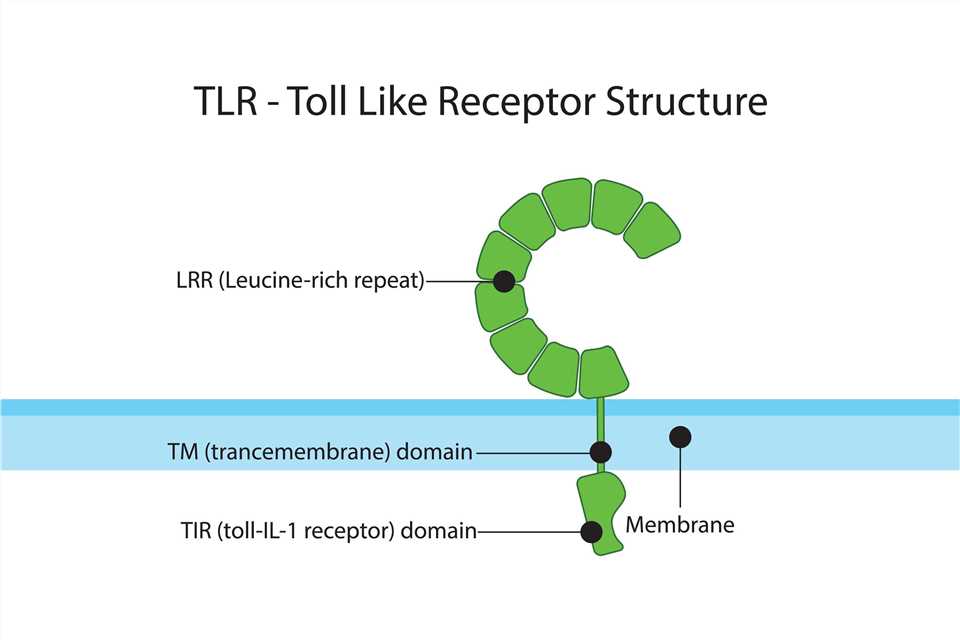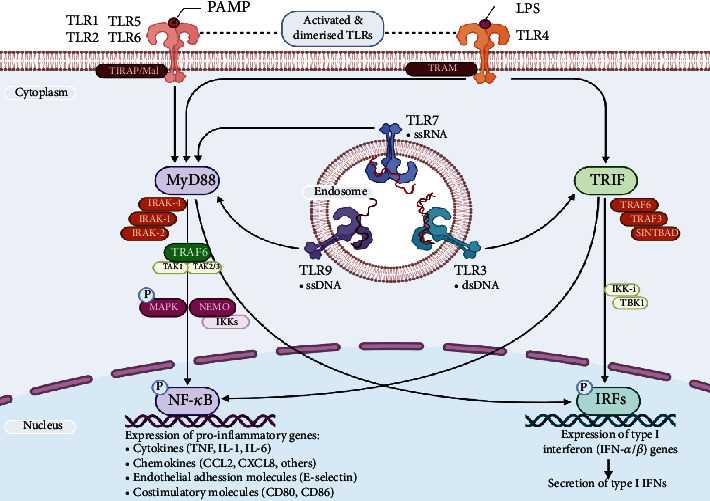Toll-Like Receptors (TLRs)
About Toll-Like Receptors (TLRs)
Toll-like receptors (TLRs) are a class of pattern recognition receptors (PRRs) that initiate the innate immune response by sensing conserved molecular patterns for early immune recognition of a pathogen. The typical TLRs are type I transmembrane proteins that contain three structural domains: a leucine-rich repeats (LRRs) motif, a transmembrane domain, and a cytoplasmic Toll/IL-1 receptor (TIR) domain. The LRRs motif is responsible for pathogen recognition, whereas the TIR domain interacts with signal transduction adaptors and initiates signaling.

TLRs are single-spanning receptors usually expressed on sentinel cells such as macrophages and dendritic cells, that recognize structurally conserved molecules derived from microbes. Once these microbes have reached physical barriers such as the skin or intestinal tract mucosa, they are recognized by TLRs, which activate immune cell responses. The TLRs include TLR1, TLR2, TLR3, TLR4, TLR5, TLR6, TLR7, TLR8, TLR9, TLR10, TLR11, TLR12, and TLR13. Humans lack genes for TLR11, TLR12, and TLR13 and mice lack a functional gene for TLR10. The receptors TLR1, TLR2, TLR4, TLR5, TLR6, and TLR10 are located on the cell membrane, whereas TLR3, TLR7, TLR8, and TLR9 are located in intracellular vesicles (because they are sensors of nucleic acids).
TLRs can recognize a wide range of PAMPs derived from bacteria, viruses, fungi, and parasites. Each TLR has specificity for specific PAMPs. For example, TLR2 recognizes bacterial lipoproteins and peptidoglycans, while TLR4 recognizes lipopolysaccharide (LPS) found in the outer membrane of Gram-negative bacteria. TLR3 recognizes viral double-stranded RNA, and TLR9 recognizes unmethylated CpG DNA motifs commonly found in bacterial and viral DNA.
Table 1 Characteristics of different human TLRs. (Sameer AS, et al., 2021)
| TLR member | TLR expression | TLR coreceptor | Gene & its location | Origin | TLR active form | Signaling adaptors |
|---|---|---|---|---|---|---|
| TLR1 | Cell membrane | TLR2 | TLR1-6-10 4p14 |
Nonviral | TLR1-TLR2 | BCAP, TIRAP, MyD88, SCIMP |
| TLR2 | Cell membrane | TLR1, 2, 6 & 10 CD14, CD36, integrin, RP105, MBL, LBP |
TLR2 4q31.3 |
Nonviral | TLR1-TLR2 TLR2-TLR2 TLR2-TLR6 TLR2-TLR10 |
BCAP, TIRAP, MyD88, SCIMP |
| TLR3 | Endoplasmic reticulum, lysosomal membrane | CD14, Mex3B | TLR3 4q35.1 |
Viral | TLR3-TLR3 | SARM, SCIMP, TRIF, TICAM1 |
| TLR4 | Cell membrane, endoplasmic reticulum, lysosomal membrane | MD2, LY96, CD14, CD36, LBP, RP105 | TLR4 9q33.1 |
Nonviral | TLR4/MD2-TLR4/MD2 TLR4-TLR6 |
BCAP, TIRAP, MyD88, SARM, SCIMP, TICAM1, TICAM2 |
| TLR5 | Cell membrane | TLR5 1q41 |
Nonviral | TLR5-TLR5 | MyD88, TICAM1 | |
| TLR6 | Cell membrane | TLR2, CD36, LBP | TLR1-6-10 4p14 |
Nonviral | TLR2-TLR6 TLR4-TLR6 |
BCAP, TIRAP, MyD88, SCIMP |
| TLR7 | Cell membrane, endoplasmic reticulum, lysosomal membrane | CD14 | TLR7 Xp22.2 |
Viral | TLR7-TLR7 | MyD88 |
| TLR8 | Endoplasmic reticulum, lysosomal membrane | TLR8 Xp22.2 |
Viral | TLR8-TLR8 | MyD88 | |
| TLR9 | Endoplasmic reticulum, lysosomal membrane | CD14 | TLR9 3p21.2 |
Viral | TLR9-TLR9 | TIRAP, MyD88, SCIMP |
| TLR10 | Cell membrane, endoplasmic reticulum, lysosomal membrane | TLR1-6-10 4p14 |
Nonviral | TLR1-TLR10 TLR2-TLR10 TLR10-TLR10 |
MyD88 |
Signaling of Toll-Like Receptors (TLRs)
Upon ligand binding, TLRs recruit adaptor proteins to their TIR domains, initiating downstream signaling pathways. The main adaptors include MyD88 (myeloid differentiation primary response 88), TRIF (TIR-domain-containing adapter-inducing interferon-β), TRAM (TRIF-related adapter molecule), and TIRAP (TIR domain-containing adaptor protein). These adaptors activate various signaling pathways, such as the NF-κB pathway and the MAPK pathway, leading to the production of pro-inflammatory cytokines, type I interferons, and other immune mediators.
 Fig. 2 Dynamics of the toll-like receptor signaling. (Sameer AS, et al., 2021)
Fig. 2 Dynamics of the toll-like receptor signaling. (Sameer AS, et al., 2021)
Available Resources for Toll-Like Receptors (TLRs)
Creative BioMart offers a wide range of quality tools related to Toll-like receptors, including recombinant proteins and more. At the same time, we provide personalized services according to the specific needs of our customers. In addition, we provide comprehensive resources, including involved pathways, protein functions, interacting proteins, related articles, and other relevant topics, to help advance research related to TLRs.
Our Featured Products
If you have any questions, requirements, or cooperation intentions, please feel free to contact us. We very much look forward to working with you and helping you achieve research and commercial success.
References:
- Sameer AS, Nissar S. Toll-Like Receptors (TLRs): Structure, functions, signaling, and role of their polymorphisms in colorectal cancer susceptibility. Biomed Res Int. 2021;2021:1157023. doi:10.1155/2021/1157023
- Vijay K. Toll-like receptors in immunity and inflammatory diseases: Past, present, and future. Int Immunopharmacol. 2018;59:391-412. doi:10.1016/j.intimp.2018.03.002
- El-Zayat S R, Sibaii H, Mannaa F A. Toll-like receptors activation, signaling, and targeting: an overview[J]. Bulletin of the National Research Centre, 2019, 43(1):187. DOI:10.1186/s42269-019-0227-2.
- Kawasaki T, Kawai T. Toll-like receptor signaling pathways. Front Immunol. 2014;5:461. Published 2014 Sep 25. doi:10.3389/fimmu.2014.00461
- Kumar H, Kawai T, Akira S. Toll-like receptors and innate immunity. Biochem Biophys Res Commun. 2009;388(4):621-625. doi:10.1016/j.bbrc.2009.08.062


